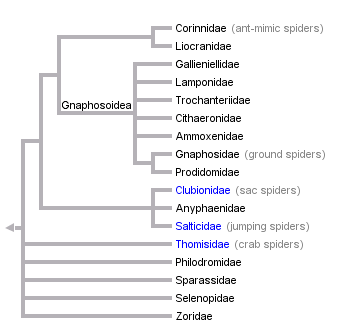Order Araneae Rank Genus | ||
 | ||
People also search for Entelegynae, Dinophora, Rousseauxia | ||
The Dionycha are a clade of spiders (Araneomorphae:Entelegynae), characterized by the possession of two tarsal claws with tufts of hairs (setae) beside them, which produce strong adhesion, enabling some species to climb glass. The circumscription of the group has varied widely; a 2014 analysis resulted in about 20 families, including Salticidae (jumping spiders), Thomisidae (crab spiders), and Clubionidae. Spiders in this group have better senses (sight, hearing) than others, some even show courtship dances and songs.
The Dionycha are now considered to be a subgroup of the larger RTA clade. Most species hunt their prey instead of building webs.
There are no cribellate members in the Dionycha.
Today it is thought that the reduction of the third claw present in ancestral spiders evolved several times independently, so this alone is not a criterion that defines the clade.
Families
In 2014, Martín J. Ramírez published a major study of the phylogeny of Dionycha. He included the families listed below, where * means that the family may not be monophyletic or there is some other reason why its inclusion is not straightforward. Two subclades were found: the "OMT clade", marked by the possession of an oblique median tapetum, and the "CTC clade", nested within the OMT clade, marked by a particular kind of claw tuft clasper.
